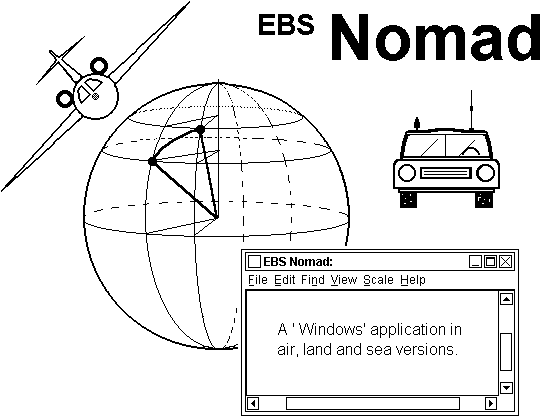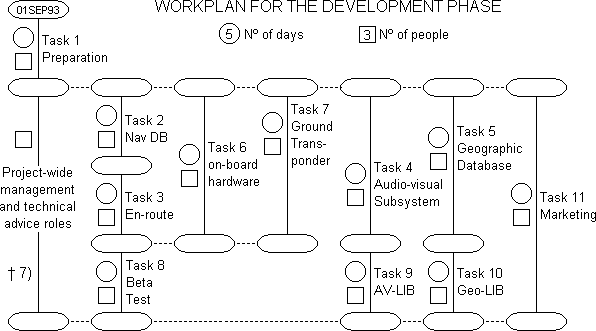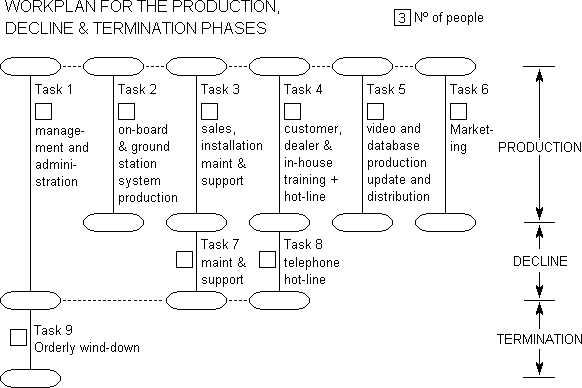
Project Outline
Life Cycle
Nomad is a high-tech product. It will therefore have a finite life-cycle made up of the following phases:
- conception of the market need and the product to fulfil it — the idea
- creation of the Technical and Commercial outline documents
- planning the tasks, skills and resources necessary to realise it
- developing the product and setting up its market infrastructure
- producing and selling the product during its marketable life-time
- transferring resources to its successor product during its decline
- termination of the product and ordered cessation of field support
The first and second phases have been completed. This document outlines the remaining five phases of Nomad's life-cycle as follows: Part 1 is the work plan for the detailed planning and development phases. Part 2 is the work plan for the production, decline and termination phases. Estimated costings of the project and the sales revenue expected from the finished product are provided in the Financial Outline document.
The design of the EBS Nomad and its presentation in this document are
the Intellectual Property and Copyright of Robert John Morton
PART 1: THE DEVELOPMENT PHASE

TASK 1 - PREPARATION
- Specify and recruit the executive team for the development phase.
- Specify and acquire accommodation for the development phase.
- Specify, acquire and install the required furniture and equipment for the development phase.
- Plan the staff recruitment programme for the development phase.
- List the major goods and services which must be sourced externally and research potential suppliers.
- Set up general management, administration and cost-monitoring procedures for the project.
- † Plan how best to re-deploy staff, accommodation and equipment at the transition from the development phase to the production phase.
TASK 2 - DEVELOP THE NAVIGATION DATABASE
- Specify, recruit and train the development team for this task.
- Acquire personal computer(s) as specified in Appendix A on which to develop the Navigation Database and En-route Information System.
- Acquire details of the air navigation aids and geographic features for the air route which will be eventually used in the Beta Test (see later).
- Design, program and test the Navigation Database & Routes File software.
- Set up and enter some test flight routes, one of which will be the route to be used later for the Beta Test.
- Write and produce the in-house documentation and user documentation.
TASK 3 - DEVELOP THE EN-ROUTE INFORMATION SYSTEM
- Specify, recruit and train the development team for this task.
- Design, program and test software to simulate an aircraft flying one of the routes set up in item 4 above. This program must provide position, heading and attitude information normally provided by an on-board GPS and attitude reference system.
- Design, program and test a simulator for weather information as provided by an aircraft's weather radar or received from a weather transponder.
- Design, program and test the en-route information presentation functions.
- Design, program and test the weather information presentation functions.
- Write and produce the in-house documentation and user documentation.
TASK 4 - DEVELOP THE AUDIO-VISUAL SUB-SYSTEM
- Specify, recruit and train the development team for this task.
- Acquire personal computer(s) as specified in Appendix A on which to develop the Audio Visual Sub-system.
- Fit or connect a CD drive to the development PC and install appropriate CD Windows interface software (which may be supplied with the drive).
- Acquire a sample audio-visual commentary on CD (any subject)
- Design, program and test the audio-visual selection and presentation functions.
- Write and produce the in-house documentation and user documentation.
TASK 5 - DEVELOP THE GEOGRAPHIC DATABASE SUB-SYSTEM
- Specify, recruit and train the development team for this task.
- Acquire personal computer(s) as specified in Appendix A on which to develop the Geographic Database System.
- Fit or connect a CD drive to the development PC and install appropriate CD Windows interface software (which may be supplied with the drive).
- Search the marketplace for providers of geographic information database software of the type required. This software must be of the client-server design with a standard message interface between the client part and the server part of the software. If a suitable one is found, go to (6).
- Specify and design bespoke database software to provide passengers with the type of geographic information discussed in the Technical Outline.
- Design, program and test the geographic information database's access and presentation functions.
- Write and produce the in-house documentation and user documentation.
- Acquire and import the geographic information on cities and geographic features on the air route to be used for the beta tests and use this data to build a test-database.
TASK 6 - DEVELOP THE ON-BOARD HARDWARE
- Specify, recruit and train the development team for this task.
- Design a PC network for installation on-board an aircraft, bearing in mind possible installation on-board coaches and other vehicles later.
- Specify and source the necessary components — special-purpose chassis & cases for aircraft installation, motherboards, aircraft-type power supply units, LCD colour displays, pointing devices, Ethernet cards, hard disk drives, tape drives, CD drives, analogue and logic input/output cards, GPS receiver kits.
- Develop, set up and Alpha Test (with software) a prototype system in-house.
- Write and produce the in-house documentation and user documentation.
TASK 7 - DEVELOP THE GROUND-BASED TRANSPONDER
- Specify, recruit and train the development team for this task.
- Search the marketplace for communications software which behaves as a client offering the standard message interface (see Task 5, Item 4) on the one side, and a suitable standard communications interface on the other.
- Select and acquire one instance of the computer equipment required to run the above in conjunction with the selected database software.
- Search the market for a radio transponder device which can interface with the above computer equipment and the selected communications software.
- Integrate and test the database software and the communications software on the above computer equipment.
- Integrate the computer and transponder equipment and test the complete transponder station in-house.
- Write and produce the in-house documentation and user documentation.
- Specify the accommodation, facilities, staff and training required to set up and run a department within a city authority for building and maintaining a ground transponder database.
TASK 8 - THE BETA TEST
- Review performance of members of the development teams and reassign suitable members to the beta-testing team.
- Design a programme of anticipated passenger usage tests for beta testing the on-board and ground-based systems.
- Set up a beta-test system on-board a passenger aircraft which flies the chosen beta test route mentioned earlier, and equip it with an on-board audio-visual commentary library and a geographic information database.
- Set up a ground-based database transponder at one of the cities on the route flown by the aircraft.
- Produce a detailed Beta-Test Report including recommendations for design update and modifications.
- Expedite any necessary updates and modifications and repeat the Beta Test task until the systems are ready for commercial use.
TASK 9 - DEVELOP THE AUDIO-VISUALS LIBRARY
- Specify, recruit and train the development team for this task.
- Acquire personal computer(s) as specified in Appendix A on which to develop the Audio Visual Commentaries system.
- Fit or connect a CD drive to the development PC and install appropriate CD Windows interface software (which may be supplied with the drive).
- Research and build a list of small video production companies who could be commissioned to produce audio-visual commentaries on cities, mountains, lakes and other geographic features world wide.
- Research and produce a list of cities and geographic features on which audio-visual commentaries should be produced and commission appropriate video production companies to produce them.
- Integrate all commentaries relating to a particular route into a CD programme so a passenger can select and play the one he wants when the aircraft is in its vicinity.
TASK 10 - DEVELOP THE GEOGRAPHIC DATABASE LIBRARY
- Specify, recruit and train the development team for this task.
- Acquire personal computer(s) as specified in Appendix A on which to develop the Geographic Database System.
- Fit or connect a CD drive to the development PC and install appropriate CD Windows interface software (which may be supplied with the drive).
- Research and build a list of organisations which build or hold databases and sources of information relating to the business, industry, transport, tourism, entertainment, history, geography, education and culture for specified cities and geographic regions.
- Extract from the list produced in Task 9 Item 5 a list of the cities only, and buy in the above data relating to each of them.
- Integrate the information relating to all cities on each air route into a single geographic information database held on a separate CD so the passenger can select and browse the information relating to the city he is interested in when it is in the vicinity of the aircraft.
TASK 11 - MARKETING
- Specify, recruit and train the development team for this task.
- Seek, find, select and brief a suitable PR & Design house to design and produce company and product literature for the Nomad product line.
- Create texts for initial approach letters to, and agendas for initial meetings with:
- market influencers such as trade press, personalities, consultants
- airlines and other potential buyers of on-board systems
- city authorities and other potential buyers of ground transponders
- dealers and franchisees who install & maintain both types of system
- Research and build prospective customer lists for all relevant market sectors.
- Put together and prime for action an integrated marketing programme for each of the above market sectors ready for product launch.
- Research and build a list of suitable candidates from which to set up a world wide dealer/franchisee infrastructure to sell, install and maintain both on-board and ground-based transponder systems.
PART 2: PRODUCTION, DECLINE & TERMINATION PHASE

TASK 1 - MANAGEMENT
A smaller management and administration team will oversee the production, decline and termination phases. It will include part-time technical consultancy and advisors to the other departments. Near the end of the production phase, this team will progressively merge with the team doing the preparation task and main management roles in the life-cycle of the next product.
TASK 2 - PRODUCTION
Set up and run a department responsible for producing both on-board and ground-based Nomad systems for the duration of the product's life-cycle.
TASK 3 - SYSTEMS
Set up and run a department responsible for managing the sales, installation, maintenance and support of both on-board and ground-based Nomad systems for airlines and city authorities etc. for the duration of the product's life-cycle.
TASK 4 - MULTI-MEDIA
Set up and run a department responsible for managing the production, updating and distribution of audio-visual commentary programmes and the geographic information databases to airlines and city authorities etc. for the duration of the product's life-cycle.
TASK 5 - TRAINING
Set up and run a department responsible for training customer, dealer and in-house staff in the operation and care of the on-board and ground-based Nomad systems for the duration of the product's life-cycle. This department will also be responsible for operating a technical hot-line service.
TASK 6 - MARKETING
Set up and run a department responsible for marketing the Nomad products to airlines and city authorities etc. for the duration of the product's life-cycle.
TASKS 7 & 8 - CONTINUED SUPPORT
Scaled-down versions of the teams previously on Tasks 2 & 3 will continue to provide maintenance, support and telephone hot-line services after production has ceased during the product's 'decline' phase.
TASK 9 - WIND-DOWN
A skeleton management team (probably mainly involved with the next product) will be available to tie up loose ends until all customers have phased out the dependency on Nomad and migrated to subsequent products.
APPENDIX A: HARDWARE & SOFTWARE DETAILS
Personal Computers:
- 80486 DX processor (with integral math co-processor)
- 16MB RAM
- 2 250MB hard disks (second acts as back-up for the first)
- 1 High Density 3½" diskette drives
- 14" top quality SVGA monitor
- mouse
- parallel port + ink jet or laser printer
- 2 CD ROM drives (to be fitted or connected when required)
- Soundblaster card, (to be fitted or connected when required)
- A-to-D and logic input card (to be fitted or connected when required)
- DOS 5.0 and Windows 3.1
- Visual C++ developer's kit
- Database development kit
On-board Systems:
- 1 Server PC with the above specification + Ethernet card
- 1 dedicated GPS receiver interfaced to the server
- 1 special interface to aircraft attitude reference system
- 1 special interface to aircraft's weather radar
- 1 special data transponder unit interfaced to server
- n naked PCs with Ethernet I/O only and LCD colour displays
Ground Database Transponders:
- 1 Server PC with the above specification
- 1 Nomad ground transponder database software
- 1 Radio transponder unit
© Robert John Morton: 21-28 May 1993



